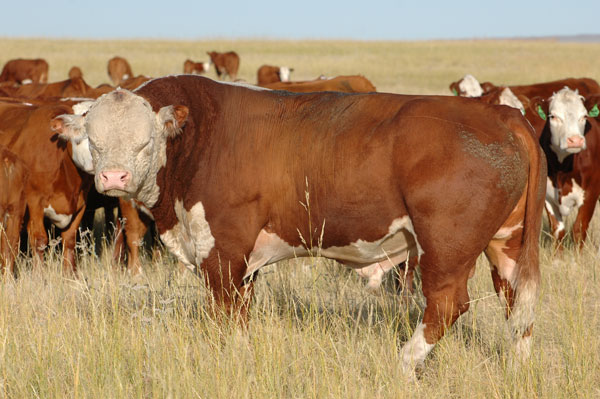Avoid These Common Breeding Season Mistakes
Tim and Chandy Olson, a South Dakota couple who have dedicated their careers to beef cattle reproduction, see several common mistakes that could be avoided.
March 1, 2011

What can you do this year to better ensure that your herd has a successful breeding season? Tim and Chandy Olson, a South Dakota couple who have dedicated their careers to beef cattle reproduction, see several common mistakes that could be avoided.
Together, the couple handles 50,000-60,000 cattle/year; Tim has worked as a beef specialist for Select Sires for the past 17 years, while Chandy is a self-employed DVM through her business CATL Resources. Tim will typically artificially inseminate (AI) over 10,000 head of cattle in a 90-day period, and Chandy will ultrasound pregnancy test 30,000 cows.
Their services range from selling semen and providing fertility and ultrasound testing to turnkey synchronization programs including heat detection and AI. The duo works with beef herds in the Dakotas, Wyoming and southeast Montana.
Four common mistakes
Based on their experiences, the Olsons suggest four management mistakes that can easily be corrected to improve your herd’s reproductive success.
1. Slowly extending the calving season. Making excuses for cows that breed late and keeping them in the herd frequently leads to problems the following year. Chandy explains, “These cows have the highest risk for being disease carriers as well as being reproductively inferior to the rest of the herd.”
2. Expecting thin cows to breed. Cattlemen must recognize that middle-aged cows handle grazing pressure and lower body condition better than young and old cows. “If the body condition of your middle-aged cows is marginal, it’s a good bet the youngest and oldest cows will have difficulty breeding under the same conditions,” Tim says.
Like what you are reading? Subscribe to Cow-Calf Weekly for more industry news in your inbox every Friday.
3. Not paying enough attention to herd bulls. Although an annual breeding soundness exam is always recommended prior to the breeding season, there are other factors that are just as integral to successful breeding, the duo says. For instance:
Yearling bulls that will breed on pasture should be adapted to grass prior to turnout and should not be overly fat at the beginning of the breeding season.
Bulls should receive prebreeding vaccinations similar to the cowherd.
Fly control and vaccinations such as pinkeye and foot rot should be considered for the bull battery.
4. Not paying enough attention to synchronization protocols. Utilizing estrus synchronization and AI can be an effective management tool to increase pregnancy and conception rates. But, attention to detail in the synchronization protocol schedule and the correct administration of synchronization drugs is very important. “Poor drug administration can take a program that usually has a 90% estrus response rate down to 50%,” Tim says.
He adds, “Many of the producers we work with on synchronization programs have shortened their breeding seasons and have up to 90% of their cows bred in less than 30 days.”
Handling is important, too
Animal handling that’s efficient and low-stress on the cattle – and people – is equally important to any successful program. Because of the volume of animals this couple handles in a year, they have firsthand knowledge about which facilities and handling tactics work..
The Olsons say the most common mistake is trying to handle too many cattle at one time. “You can handle large numbers in a day, but you’ve got to bring them into the crowd pen and alley three to four head at a time,” Tim says. “You may take more steps in a day, but you can work the cattle a lot faster.”
It’s not uncommon for the couple to easily work 500-1,000 head/day. “We’ve done nearly 1,100 head in six hours using portable equipment,” Tim reports.
In addition to working a few head at a time, Tim emphasizes the importance of working cattle in an alley from “front to back.”
“The natural tendency is to go to the cow’s hip, but cattle cooperate better when they can see you. You need to get her attention by walking past her head; she will move forward almost all the time.”
For producers looking to improve their handling facilities, the Olsons say it’s important to design a system that can be operated with just one or two people. Tim has provided input to numerous producers in designing their facilities, and was consulted in the design of cattle facilities at the North Dakota State University Research Center in Carrington.
They also believe that portable equipment set up in a pasture is a viable option. They frequently synchronize, breed and preg-check 500-1,000 head/day with such facilities.
Sidebar: Preg-checking is a report card
Once breeding season is complete, Chandy Olson, DVM, says ultrasound pregnancy testing the herd is an equally important management tool to determine calving dates and identify any fertility concerns.
Herds with an abnormal amount of open or late calving cows may indicate a reproductive-disease problem, a bull fertility problem, or more frequently a nutritional or stocking rate problem.
She says the best time to ultrasound is between 30 and 100 days of gestation – but can be done as late as 120 days. Frequently producers will ultrasound cows when they precondition calves because the cows and calves are already sorted.
Based on the calving date information, Olson says cows can be divided into calving groups that are 20-30 days apart (i.e., early, middle and late calving groups). This can help decrease feed costs and focus labor efforts during calving.
Kindra Gordon is a freelancer based in Whitewood, SD.
You might also like:
Commercial Cattleman Builds Back His Herd Using DNA Marker Technology
What Is The Future Of Biotechnology In The Beef Industry?
About the Author(s)
You May Also Like



